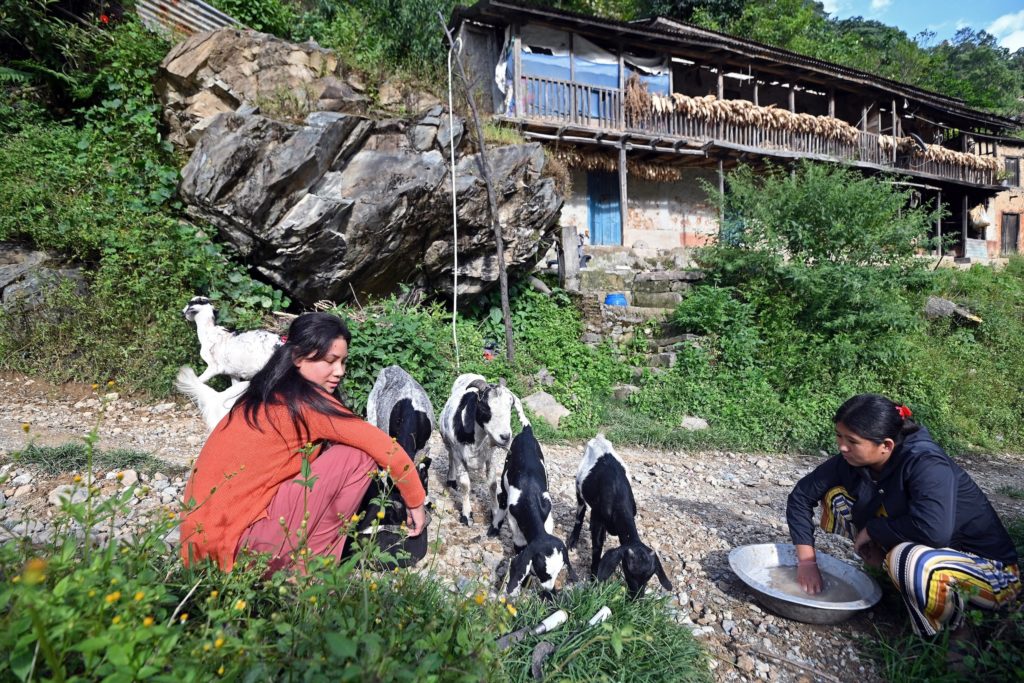Challenges Faced by Local Governments Regarding Illegal Excavation and Mining
Research findings from Tribhuvan University's 2064 study on 'Excavation and Quality Status in Northern Kathmandu' highlighted concerns and opposition to the unauthorized excavation of rivers and mineral resources since 2062. With the promulgation of the new constitution in 2072, local authorities gained rights related to these issues, leading to an increase in associated problems.
In 2074, the parliament enacted the Local Government Operation Act, granting municipalities the authority to contract for the excavation and collection of river materials. This marked a shift from the central government holding exclusive rights to this power before 2072.
Despite this, many political leaders appear involved in the mining industry themselves, raising questions about conflicts of interest. In the 2079 local elections, nearly 200 out of approximately 8,300 elected representatives had direct or indirect involvement in mining and construction contracts, especially related to excavation of gravel and crusher industries.
The Tikabhairav region, situated five kilometers beyond Lalitpur's Tikabhairav Bazaar, is illustrative of the issue. Most political leaders seem unaware of the inherent conflict of interest. For instance, Mahajan questioned, "Why do representatives engage in business for personal economic gains?"
Environmental expert Bhushan Tuladhar sees the matter not only as environmental but also as a governance issue. He points out that federalism has accelerated development at the local level but has also centralized adverse effects.
Moreover, centralization has created conflicting jurisdictional rights, as highlighted by Balananda Poudel, Chairperson of the National Natural Resources and Fiscal Commission. He emphasizes the need for the constitutional body to ensure fair distribution of natural and financial resources among the federal, provincial, and local governments.
However, the lack of resources hampers effective monitoring and enforcement. According to Madhu Ghimire, Under-Secretary at the Ministry of Forests and Environment, a proper evaluation and impact assessment of environmental effects are crucial but are currently underutilized due to resource constraints.
Existing policies prohibit excavation and mining within a certain radius of settlements, within 500 meters of highways, and within one kilometer of riverbanks and bridge crossings. Still, Rishidev Fuyal, Chief of Lalitpur's District Coordination Committee, points out that the enforcement and monitoring of these regulations are lacking due to a shortage of resources and cooperation between the Forest and Police Departments.
Padam Shrestha, an environmental lawyer and rights activist, reveals that of the 753 municipalities, more than half do not follow appropriate measurement standards. He claims that authorities often fail to adhere to the prescribed standards due to a lack of oversight.
The consequence of the 2079 amendment to excavation and mining regulations resulted in restrictions but also faced a temporary suspension due to an interim court order. Shrestha highlights that despite legal challenges, many businesses continue to operate without adherence to regulations.
Sita Ram Nyapane, the president of the National Association of Crusher Industries, argues that the new standards for environmental protection have hindered the industry's renewal process. He states, "According to these standards, we are all illegal. Instead of providing guidance, the government has put additional burdens on entrepreneurs with standards we cannot comply with."
A solution to these problems may lie in new parliamentary legislation. The proposed bill aims to provide clear guidelines for the management and regulation of construction materials. The spokesperson for the Ministry of Federal Affairs and General Administration, Kumar Bhattarai, states that the bill is under consideration in the Cabinet.
In conclusion, the complex issue of illegal excavation and mining in Nepal requires a multi-faceted approach. Striking a balance between environmental protection, local development, and effective governance is crucial to ensuring sustainable practices in the extraction of natural resources.
Research findings from Tribhuvan University's 2064 study on 'Excavation and Quality Status in Northern Kathmandu' highlighted concerns and opposition to the unauthorized excavation of rivers and mineral resources since 2062. With the promulgation of the new constitution in 2072, local authorities gained rights related to these issues, leading to an increase in associated problems.
In 2074, the parliament enacted the Local Government Operation Act, granting municipalities the authority to contract for the excavation and collection of river materials. This marked a shift from the central government holding exclusive rights to this power before 2072.
Despite this, many political leaders appear involved in the mining industry themselves, raising questions about conflicts of interest. In the 2079 local elections, nearly 200 out of approximately 8,300 elected representatives had direct or indirect involvement in mining and construction contracts, especially related to excavation of gravel and crusher industries.
The Tikabhairav region, situated five kilometers beyond Lalitpur's Tikabhairav Bazaar, is illustrative of the issue. Most political leaders seem unaware of the inherent conflict of interest. For instance, Mahajan questioned, "Why do representatives engage in business for personal economic gains?"
Environmental expert Bhushan Tuladhar sees the matter not only as environmental but also as a governance issue. He points out that federalism has accelerated development at the local level but has also centralized adverse effects.
Moreover, centralization has created conflicting jurisdictional rights, as highlighted by Balananda Poudel, Chairperson of the National Natural Resources and Fiscal Commission. He emphasizes the need for the constitutional body to ensure fair distribution of natural and financial resources among the federal, provincial, and local governments.
However, the lack of resources hampers effective monitoring and enforcement. According to Madhu Ghimire, Under-Secretary at the Ministry of Forests and Environment, a proper evaluation and impact assessment of environmental effects are crucial but are currently underutilized due to resource constraints.
Existing policies prohibit excavation and mining within a certain radius of settlements, within 500 meters of highways, and within one kilometer of riverbanks and bridge crossings. Still, Rishidev Fuyal, Chief of Lalitpur's District Coordination Committee, points out that the enforcement and monitoring of these regulations are lacking due to a shortage of resources and cooperation between the Forest and Police Departments.
Padam Shrestha, an environmental lawyer and rights activist, reveals that of the 753 municipalities, more than half do not follow appropriate measurement standards. He claims that authorities often fail to adhere to the prescribed standards due to a lack of oversight.
The consequence of the 2079 amendment to excavation and mining regulations resulted in restrictions but also faced a temporary suspension due to an interim court order. Shrestha highlights that despite legal challenges, many businesses continue to operate without adherence to regulations.
Sita Ram Nyapane, the president of the National Association of Crusher Industries, argues that the new standards for environmental protection have hindered the industry's renewal process. He states, "According to these standards, we are all illegal. Instead of providing guidance, the government has put additional burdens on entrepreneurs with standards we cannot comply with."
A solution to these problems may lie in new parliamentary legislation. The proposed bill aims to provide clear guidelines for the management and regulation of construction materials. The spokesperson for the Ministry of Federal Affairs and General Administration, Kumar Bhattarai, states that the bill is under consideration in the Cabinet.
In conclusion, the complex issue of illegal excavation and mining in Nepal requires a multi-faceted approach. Striking a balance between environmental protection, local development, and effective governance is crucial to ensuring sustainable practices in the extraction of natural resources.
Challenges Faced by Local Governments Regarding Illegal Excavation and Mining
Research findings from Tribhuvan University's 2064 study on 'Excavation and Quality Status in Northern Kathmandu' highlighted concerns and opposition to the unauthorized excavation of rivers and mineral resources since 2062. With the promulgation of the new constitution in 2072, local authorities gained rights related to these issues, leading to an increase in associated problems.
In 2074, the parliament enacted the Local Government Operation Act, granting municipalities the authority to contract for the excavation and collection of river materials. This marked a shift from the central government holding exclusive rights to this power before 2072.
Despite this, many political leaders appear involved in the mining industry themselves, raising questions about conflicts of interest. In the 2079 local elections, nearly 200 out of approximately 8,300 elected representatives had direct or indirect involvement in mining and construction contracts, especially related to excavation of gravel and crusher industries.
The Tikabhairav region, situated five kilometers beyond Lalitpur's Tikabhairav Bazaar, is illustrative of the issue. Most political leaders seem unaware of the inherent conflict of interest. For instance, Mahajan questioned, "Why do representatives engage in business for personal economic gains?"
Environmental expert Bhushan Tuladhar sees the matter not only as environmental but also as a governance issue. He points out that federalism has accelerated development at the local level but has also centralized adverse effects.
Moreover, centralization has created conflicting jurisdictional rights, as highlighted by Balananda Poudel, Chairperson of the National Natural Resources and Fiscal Commission. He emphasizes the need for the constitutional body to ensure fair distribution of natural and financial resources among the federal, provincial, and local governments.
However, the lack of resources hampers effective monitoring and enforcement. According to Madhu Ghimire, Under-Secretary at the Ministry of Forests and Environment, a proper evaluation and impact assessment of environmental effects are crucial but are currently underutilized due to resource constraints.
Existing policies prohibit excavation and mining within a certain radius of settlements, within 500 meters of highways, and within one kilometer of riverbanks and bridge crossings. Still, Rishidev Fuyal, Chief of Lalitpur's District Coordination Committee, points out that the enforcement and monitoring of these regulations are lacking due to a shortage of resources and cooperation between the Forest and Police Departments.
Padam Shrestha, an environmental lawyer and rights activist, reveals that of the 753 municipalities, more than half do not follow appropriate measurement standards. He claims that authorities often fail to adhere to the prescribed standards due to a lack of oversight.
The consequence of the 2079 amendment to excavation and mining regulations resulted in restrictions but also faced a temporary suspension due to an interim court order. Shrestha highlights that despite legal challenges, many businesses continue to operate without adherence to regulations.
Sita Ram Nyapane, the president of the National Association of Crusher Industries, argues that the new standards for environmental protection have hindered the industry's renewal process. He states, "According to these standards, we are all illegal. Instead of providing guidance, the government has put additional burdens on entrepreneurs with standards we cannot comply with."
A solution to these problems may lie in new parliamentary legislation. The proposed bill aims to provide clear guidelines for the management and regulation of construction materials. The spokesperson for the Ministry of Federal Affairs and General Administration, Kumar Bhattarai, states that the bill is under consideration in the Cabinet.
In conclusion, the complex issue of illegal excavation and mining in Nepal requires a multi-faceted approach. Striking a balance between environmental protection, local development, and effective governance is crucial to ensuring sustainable practices in the extraction of natural resources.
0 التعليقات
0 المشاركات
5كيلو بايت مشاهدة
0 معاينة


